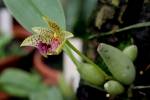Anubias afzelii blooming
Anubias afzelii is quite a big plant compared with other aquatic plants, as its mature specimen can grow up to a meter’s high. Aquarists prefer young plants to decorate their tanks. Such bushes grow very slowly when planted submerged and keep their small size for a long time. In the tank Anubias normally has not more than 5-7 leaves (the old ones die off, the new ones grow too slowly). It blooms also very seldom, as a rule only in a full-grown state, and when kept in a greenhouse. My plant started to bloom only in the 5th year. Its inflorescence is big and very beautiful, so these years of waiting were not spent for nothing. It’s worth seeing at least once!
Some parameters of my blooming specimen:
The full-grown leaf. The lamina is 38 х 9 cm. The petiole is 47 cm.
The inflorescence. The peduncle is 40 cm long. The spadix is 9 cm. The spatha is only 5 mm shorter than the spadix. The female part is 3 cm, the male part is 6 cm. On the first day of blooming the spatha bursts completely, exposing the female part. On the second day the female flowers excrete the clammy liquid. The blooming finishes on the third day, when the spatha covers the spadix tightly, and pollen ripens on the male part.
First day: the spatha has s shape of a boat, the spadix, its male and female parts are now open. There is no pollen yet, but the stigmas are also dry. Perhaps the female flowers are not ready for the pollination or the “dryness” is an effect of the environmental conditions.
Second day: the spatha is still open, but the pollen isn’t available. The stigmas became wet.
Third day: the spatha closed completely and wrapped the spadix except its top. You can see the pollen on the synandria (grown together pollen grains).
Anubias afzelii conventionally belongs to the group of narrow-leafed Anubia alongside with Anubias barteri var. glabra, Anubias barteri var. angustifolia and Anubias heterophylla. Though there is some similarity, Anubias afzelii differs through the big size of full-grown bushes, and there is no need to wait for it to bloom. Other varieties listed above normally have smaller size (full-grown plants rarely reach a half-meter height). However, it should be taken into account, that the conditions of keeping also influence the size of plants in a great extent.
Translation: A. Grigorov, J. Niklyaeva.
Photos: D. Loginov.








